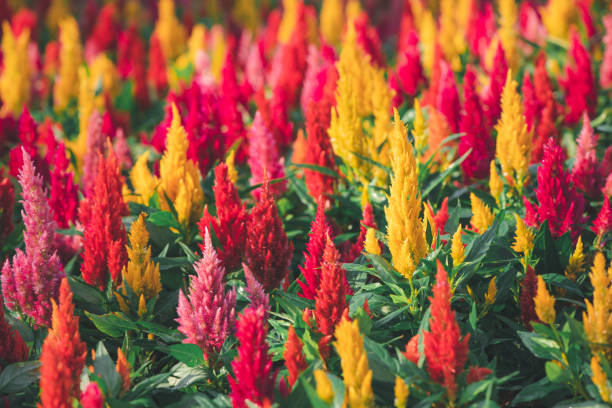With its flame-like plumes or coral-shaped blooms, Celosia adds drama and vivid color to gardens and arrangements alike. Whether you choose the feathery plumosa variety, the brain-like cristata (cockscomb), or the spiky spicata, celosia always stands out. These annuals are beloved for their vibrant reds, oranges, pinks, and yellows, lasting well into the fall.
Originally from tropical regions of Africa and Asia, celosias are heat-loving, sun-craving plants that thrive in garden beds, borders, and containers. Their blooms are long-lasting both in the ground and as cut or dried flowers, making them versatile additions to your gardening palette.

Portrait of the Celosia
Celosia belongs to the Amaranthaceae family and includes several species and cultivars. The three most popular types are:
- Celosia argentea var. plumosa – feather-like plumes
- Celosia cristata – brain-shaped “cockscomb”
- Celosia spicata – wheat-like flower spikes
These plants grow quickly, blooming all summer with minimal care as long as their warmth and sun requirements are met.
Foliage and Form
Celosia grows in upright clusters with bright green, sometimes reddish or bronze-tinted leaves. Depending on the variety, they range from short, bushy plants to taller, narrow spires.
- Height: 20–100 cm (8–40 inches)
- Spread: 15–45 cm (6–18 inches)
- Growth habit: Upright, bushy or spiky forms
- Foliage: Ovate, smooth, green to burgundy leaves
Blooms and Fragrance
Celosia flowers are prized for their unusual textures and fiery colors. While not fragrant, their visual impact and long bloom time make them a standout.
- Bloom time: Summer through fall
- Color: Bright red, pink, yellow, orange, and purple
- Fragrance: None
- Texture: Velvety or feathery depending on the variety
Planting, Flowering, and Pruning Calendar
| Month | Planting (Seeds) | Flowering | Pruning/Deadheading |
|---|---|---|---|
| January | ❌ | ❌ | ❌ |
| February | ❌ | ❌ | ❌ |
| March | ✅ (indoors) | ❌ | ❌ |
| April | ✅ (indoors) | ❌ | ❌ |
| May | ✅ (transplant outdoors) | ✅ | ✅ (start deadheading) |
| June | ❌ | ✅ | ✅ |
| July | ❌ | ✅ | ✅ |
| August | ❌ | ✅ | ✅ |
| September | ❌ | ✅ | ✅ |
| October | ❌ | ✅ | ✅ (final clean-up) |
| November | ❌ | ❌ | ❌ |
| December | ❌ | ❌ | ❌ |
✅ = Recommended ❌ = Not advised
Watering, Sunlight, Indoor vs Outdoor, Temperature
- Watering: Moderate. Water when the top 2–3 cm of soil dries. Avoid overwatering—celosia is drought-tolerant once established.
- Sunlight: Full sun (at least 6–8 hours daily) is essential for flowering and color intensity.
- Indoor vs Outdoor: Best grown outdoors, but can be started indoors from seed. Not suitable as a long-term houseplant.
- Temperature: Thrives in warm weather (21–29°C / 70–85°F). Sensitive to cold and frost; wait until after the last frost to transplant.
Ideal Soil Conditions
| Soil Feature | Optimal Condition | Why It Matters |
|---|---|---|
| Type | Well-draining, loamy | Prevents root rot and supports steady growth |
| Texture | Light, loose | Encourages root spread and aeration |
| Drainage | Excellent | Standing water can damage the roots |
| Moisture | Slightly moist but never soggy | Balances drought tolerance with blooming needs |
| pH | Neutral to slightly acidic (6.0–7.0) | Helps nutrient uptake |
| Fertility | Moderate, with occasional liquid fertilizer | Promotes flowering without excessive leaf growth |
Common Problems & Solutions
| Issue ⚠️ | Symptoms 🔍 | Solutions 🛠️ |
|---|---|---|
| Root rot 💧 | Wilting, yellow leaves, soggy soil | Improve drainage, reduce watering |
| Powdery mildew 🌫️ | White fungal coating on leaves | Increase airflow, avoid overhead watering |
| Leggy growth 🌱 | Tall, spindly stems, few flowers | Increase light exposure, pinch back early |
| Aphids 🐜 | Sticky residue, curled leaves | Use insecticidal soap or hose off pests |
| Weak blooms 🌸 | Few flowers, dull colors | Provide more sun, use phosphorus-rich feed |
Celosia is an eye-catching, low-maintenance addition to your garden, perfect for adding texture and bold color. Whether you favor feathery plumes or velvety cockscombs, celosia will light up your garden from summer to frost.